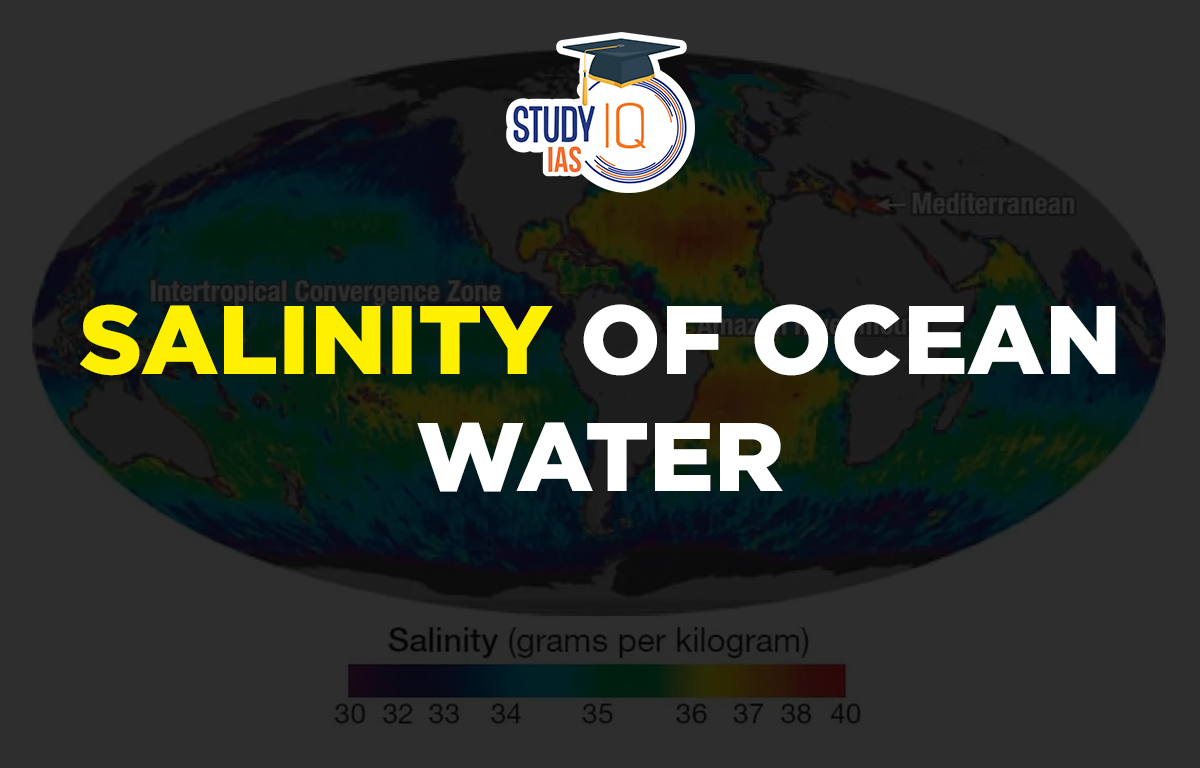Table of Contents
Salinity of Ocean Water
Seawater is salty because it contains dissolved chemicals mainly from rocks and soil carried by rivers. The main source of salt in seawater is sodium chloride. The total amount of dissolved salt in seawater is called salinity, measured in grams of salt per 1000 grams (1 kg) of seawater. Ocean salinity is often expressed as parts per thousand (ppt). If the salinity is 24.7 ppt, the water is known as brackish water.
Salinity affects compressibility, humidity, absorption, thermal expansion, temperature, and density of seawater. It affect the distribution of fish and other marine resources as well as the composition and movement of the sea. Examples of high-salinity water bodies include:
- Lake Van in Turkey: 330 ppt
- Dead Sea: 238 ppt
- Great Salt Lake: 220 ppt
The major composition of the different salts in the sea is
- Sodium chloride: 77.7%
- Magnesium Chloride: 10.9%
- Magnesium Sulphate: 4.7%
- Calcium Sulphate: 3.6%
- Potassium Sulphate: 2.5%
Read about: Indian Ocean Dipole
Factors Affecting Salinity of Ocean Water
| Factor affecting salinity of Ocean water |
|
Read More: Ocean Deposits
Salinity of Ocean Water Significance
- The density of seawater, as well as its vertical flow patterns in the thermohaline circulation, are determined by salinity and temperature.
- The physical processes affecting a water mass when it was last at the surface are recorded by salinity.
- Freezing/thawing – salts excluded from vapour precipitation/evaporation – salts excluded from the ice
- For determining the origin and mixing of water types, salinity can be used as a conservative (unchanging) tracer.
Read More: Ocean Tides
Salinity Distribution of Ocean Water
Surface seawater salinity is mainly influenced by evaporation and precipitation. Near the equator, rainfall from rising air creates low salinity, while high salinity occurs in hot, dry areas (20-30 degrees latitude) where air descends. The North Atlantic is saltier than the North Pacific, making its surface water denser and causing it to sink. This is partly because the North Atlantic is warmer (about 10 °C) than the North Pacific (about 6.7 °C). Below 1000 meters salinity levels are relatively stable ranging from 34.5 to 35.0 across all latitudes. Salinity typically decreases with depth in low and mid-latitudes, creating areas known as haloclines. Researchers study salinity distribution using two methods: horizontal and vertical distribution.
Read More: Ocean Waves
Horizontal Distribution of Salinity
Salinity generally decreases from the equator to the poles. Although the equator has high temperatures and evaporation, heavy rainfall lowers salt concentration, making it only account for 35% of salinity. The highest salinity is found between 20° N and 40° N, where temperatures are high, evaporation is strong, and rainfall is low. In the southern hemisphere, average salinity is around 35 between 10° and 30° latitude. Areas between 40° and 60° latitude in both hemispheres have lower salinity, around 31 in the north and 33 in the south.
Read More: Ocean Currents
Vertical Distribution of Salinity
Salinity at the sea surface can be lowered by adding freshwater or increased by losing water through ice formation or evaporation. This means salinity can change with depth. In high latitudes salinity increases from 300 to 1000 meters deep because denser water is below, but it stays constant beyond 1000 meters. In low latitudes, salinity decreases between 300 and 1000 meters, then also levels off after that. The area between 300 and 1000 meters, where salinity changes rapidly, is called the halocline. The upper layer of the ocean has the highest salinity while the deeper layers have lower salinity creating a transition zone known as the halocline. In low latitudes, the upper layer is saltier, while in high latitudes, it’s less salty.
Read More: Dead Sea
Salinity of Ocean Regional Distribution
- The Indian Ocean has an average salinity of 35 parts per thousand. The low salinity in the Bay of Bengal is caused by the influx of river water from the Ganga.
- The Arabian Sea, on the other hand, has a higher salinity due to high evaporation and a low freshwater influx.
- The Pacific Ocean’s salinity variation is primarily due to its shape and larger area extent.
- The salinity of the Atlantic Ocean varies from 20 to 37 parts per thousand depending on location.
- Near the equator, for example, there is heavy rainfall, high relative humidity, cloudiness, and the calm air of the doldrums.
- The polar regions, on the other hand, experience very little evaporation and receive large amounts of freshwater from ice melting. This results in low salinity levels ranging between 20 and 32 parts per thousand.
- Despite its higher latitude, the North Sea has higher salinity due to more saline water brought by the North Atlantic Drift.
- Due to high evaporation, the Mediterranean Sea has a higher salinity. This sea’s surface waters average around 38 parts per thousand.
- The Baltic Sea has a low salinity due to a large influx of river waters, averaging around 35 parts per thousand.
- The Black Sea’s salinity is very low due to the massive freshwater influx from rivers, averaging around 13-23 parts per thousand.
Read More: Sea of Okhotsk
Salinity of Ocean UPSC
Along with temperature, salinity has a direct impact on seawater density (salty water is denser than freshwater) and thus the circulation of ocean currents from the tropics to the poles. One method for delving deeper into the water cycle is to measure salinity. We discussed the salinity of ocean water in this article. This article investigates the factors that influence the salinity of oceanic waters and the surface salinity of the world’s oceans. Finally, we discussed the significance of the Salinity of the ocean which is useful for the UPSC exam.


 Jallianwala Bagh Massacre, Date, History...
Jallianwala Bagh Massacre, Date, History...
 Important Lakes of India, State wise and...
Important Lakes of India, State wise and...
 Buddhism History, Origin, Sect, Councils...
Buddhism History, Origin, Sect, Councils...





















